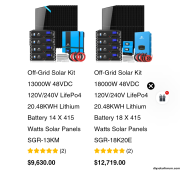Yes. Your array must accommodate all the energy needs in a 24 hour period - as I've stated multiple times.
Well, there's one piece of the puzzle. 4.25 hours irradiance.
Since you've given a time window, is there shading outside those hours? 4.25 hours means no shading from sunrise to sunset based on your array orientation input to get that number.
Okay, so you've finally arrived at the requested 24 hour number? 22kWh? Whew. Finally.
Kits schmits. YOU need to design your system based on YOUR goals/needs. THEN you decide if you can find a kit that meets your needs.
Incorrect.
Power consumption used in a 24 hour period determines the minimum array size. Period.
Since you've finally divulged your 24 hour consumption:
22kWh/4.25h = 5.17kW array = minimum array size to meet 22kWh daily demand.
See how it doesn't matter one bit when the power is used?
Absolutely, but the same rules apply.
But your mind is failing to draw the right conclusion. 24 hour consumption determines array size. Period. You've literally calculated it that way. What difference does it make if the numbers were reversed? 16kWh during the day and 6kWh at night.... not one bit.
Now, you've estimated that you need 16kWh of battery due to nightly consumption. This means that you'll have to:
- Always have clear skies and perfect solar conditions - no clouds, etc.
- Never over-consume during the daytime.
- Deliberately NOT consume during the day in hopes of having enough to get through the night.
It's these variables that further encourage one to assume the batteries need to cover a full 24 hours of consumption. If you're willing to whip out the generator any time you fall short, that's fine. Maybe only 16kWh is enough.
Additionally, with a 5.2kW array, you're going to fall short some days. You have two choices:
- Increase the array size (25-50%) to ensure that you can "catch up" when good days follow bad.
- Run the generator with each shortfall.
Now you can pick your kit.



